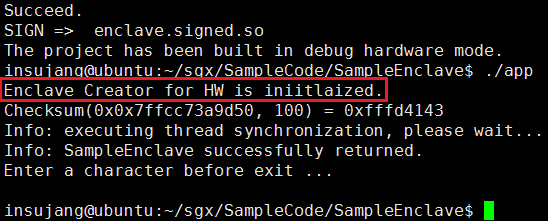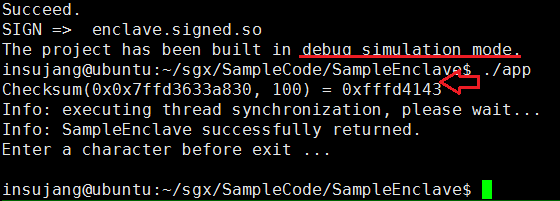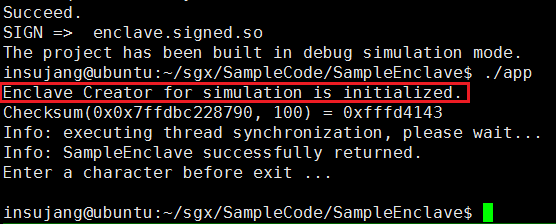Intel SGX SDK Functions for Enclave Creation
Table of Contents
Many research papers have dealed about how SGX internally works, however, none have handled how SGX SDK works.
This post explains how Intel Linux SGX SDK calls Intel SGX CPU instructions, to create an enclave.
As we all know, There is an SGX instruction we use to create an enclave, EADD. This is a Intel CPU microcode instruction. However, a user program does not directly call this instruction, but calls sgx_create_enclave() SDK function. How this function is related to EADD?
1. sgx_create_enclave() #
At first, we include "sgx_urts.h" to use untrusted sgx library functions when programming a SGX user program. The header is in /linux-sgx/common/inc/sgx_urts.h, and its implementation is in linux-sgx/psw/urts/linux/urts.cpp.
/linux-sgx/common/inc/sgx_urts.h
sgx_status_t SGXAPI sgx_create_enclave(const char *file_name, const int debug, sgx_launch_token_t *launch_token, int *launch_token_updated, sgx_enclave_id_t *enclave_id, sgx_misc_attribute_t *misc_attr);
#include "urts_com.h"
extern "C" sgx_status_t sgx_create_enclave(const char *file_name, const int debug, sgx_launch_token_t *launch_token, int *launch_token_updated, sgx_enclave_id_t *enclave_id, sgx_misc_attribute_t *misc_attr)
{
sgx_status_t ret = SGX_SUCCESS;
...
ret = _create_enclave(!!debug, fd, file, NULL, launch_token, launch_token_updated, enclave_id, misc_attr);
...
return ret;
}
2. _create_enclave() #
As indicated, _create_enclave() is declared and defined in /linux-sgx-/psw/urts/urts_com.h. It calls an internal function defined in the same file, __create_enclave().
static int __create_enclave(BinParser &parser, uint8_t* base_addr, const metadata_t *metadata, se_file_t& file, const bool debug, SGXLaunchToken *lc, le_prd_css_file_t *prd_css_file, sgx_enclave_id_t *enclave_id, sgx_misc_attribute_t *misc_attr)
{
...
CEnclave* enclave = new CEnclave(loader);
// initialize the enclave object
ret = enclave->initialize(file,
loader.get_enclave_id(),
const_cast<void*>(loader.get_start_addr()),
metadata->enclave_size,
metadata->tcs_policy);
...
//call trts to do some intialization
if(SGX_SUCCESS != (ret = get_enclave_creator()->initialize(loader.get_enclave_id())))
{
sgx_status_t status = SGX_SUCCESS;
CEnclavePool::instance()->remove_enclave(loader.get_enclave_id(), status);
goto fail;
}
...
}
3. get_enclave_creator() #
At the first time, I taught that CEnclave is an enclave created by CPU, however, it is just a container for a software. Actual enclave is not created by this function call. Instead, get_enclave_creator()->initialize() function makes an actual enclave.
get_enclave_creator() function is defined in /linux-sgx/psw/urts/loader.cpp.
// enclave creator instance
extern EnclaveCreator* g_enclave_creator;
EnclaveCreator* get_enclave_creator(void)
{
return g_enclave_creator;
}
4. g_enclave_creator #
At here, a function that allocates a class instance for g_enclave_creator depends on SGX running mode; simulation, or hardware.
SGX running mode #
When we compile a sample code, we can put an option named SGX_MODE, the value of which is either SIM or HW. The instruction says that we can use SGX_MODE=SIM to run it in simulation mode, and SGX_MODE=HW to run it in hardware mode. Some different libraries are linked in terms of the value of the option.
Hardware mode #
When compiling a program with SGX_MODE=HW, g_enclave_creator is initialized in linux-sgx/psw/urts/linux/enclave_creator_hw.cpp.
EnclaveCreator* g_enclave_creator = new EnclaveCreatorHW();
static uint64_t g_eid = 0x1;
EnclaveCreatorHW is a child class, inheriting EnclaveCreator class. EnclaveCreatorHW is declared in /linux-sgx/psw/urts/enclave_creator_hw.h.
Its implementation seems to be divided into two cpp files: /linux-sgx/psw/urts/enclave_creator_hw_com.cpp and /linux-sgx/psw/urts/linux/enclave_creator_hw.cpp.
The constructor and create_enclave() function is defined in /linux-sgx/psw/urts/linux/enclave_creator_hw.cpp.
EnclaveCreatorHW::EnclaveCreatorHW():
m_hdevice(-1),
m_sig_registered(false)
{
se_mutex_init(&m_sig_mutex);
}
int EnclaveCreatorHW::create_enclave(secs_t *secs, sgx_enclave_id_t *enclave_id, void **start_addr, bool ae)
{
...
}
I intentionally add a printf() call in the constructor function, and check whether it is printed.
EnclaveCreatorHW::EnclaveCreatorHW():
m_hdevice(-1),
m_sig_registered(false)
{
printf("Enclave Creator for HW is iniitlaized.\n");
se_mutex_init(&m_sig_mutex);
}
I used a sample user program provided by Intel, SampleEnclave.

- The result when compiling the sample enclave with
SGX_MODE=HW. {: .center}
prints() is called when the program is compiled with the option SGX_MODE=HW, however, it is not called when it is compiled with the option SGX_MODE=SIM.

- The result when compiling the sample enclave with
SGX_MODE=SIM. {: .center}
Simulation mode #
The above result means that there is another enclave creator for simulation mode.
In the simulation mode, g_enclave_creator is initialized in /linux-sgx/sdk/simulation/urtssim/enclave_creator_sim.cpp as follows.
EnclaveCreator* g_enclave_creator = new EnclaveCreatorSim();
EnclaveCreatorSim class is declared in /linux-sgx/sdk/simulation/urtssim/enclave_creator_sim.h, and its functions are defined in /linux-sgx/sdk/simulation/urtssim/enclave_creator_sim.cpp.
There is no overridden constructor, so I put a printf() call in EnclaveCreatorSim::create_enclave() function.
int EnclaveCreatorSim::create_enclave(secs_t *secs, sgx_enclave_id_t *enclave_id, void **start_addr, bool ae)
{
UNUSED(ae);
printf("Enclave Creator for simulation is initialized.\n");
return ::create_enclave(secs, enclave_id, start_addr);
}

- The result when compiling the sample enclave with
SGX_MODE=SIM. {: .center}
5. EnclaveCreatorHW::create_enclave() #
In simulation mode, Intel SGX SDK does not use any CPU’s SGX instructions. So Let’s see the internal function call flows of EnclaveCreatorHW class.
int EnclaveCreatorHW::create_enclave(secs_t *secs, sgx_enclave_id_t *enclave_id, void **start_addr, bool ae)
{
...
ret = ioctl(m_hdevice, SGX_IOC_ENCLAVE_CREATE, ¶m);
...
}
It passes its control to Intel SGX driver to call ECREATE, which is a ECLS instruction the can only be called in kernel mode.
This ioctl() call is passed through Intel SGX Linux driver, and calls the function isgx_ioctl_enclave_create() in /linux-sgx-driver/isgx_ioctl.c.
static long isgx_ioctl_enclave_create(struct file *filep, unsigned int cmd,
unsigned long arg)
{
...
ret = __ecreate((void *) &pginfo, secs_vaddr);
isgx_put_epc_page(secs_vaddr);
if (ret) {
isgx_info(enclave, "ECREATE returned %d\n", (int)ret);
goto out;
}
...
}
__ecreate() function is defined in /linux-sgx-driver/isgx_arch.h.
static inline unsigned long __ecreate(struct page_info *pginfo, void *secs)
{
return __encls(ECREATE, pginfo, secs, "d"(0));
}
__encls function is defined as a macro, with C inline assembly function as follows, in /linux-sgx-driver/isgx_arch.h.
#ifdef CONFIG_X86_64
#define __encls(rax, rbx, rcx, rdx...) \
({ \
int ret; \
asm volatile("1: .byte 0x0f, 0x01, 0xcf;\n\t" \
" xor %%eax,%%eax;\n" \
"2: \n" \
".section .fixup,\"ax\"\n" \
"3: movq $-1,%%rax\n" \
" jmp 2b\n" \
".previous\n" \
_ASM_EXTABLE(1b, 3b) \
: "=a"(ret), "=b"(rbx), "=c"(rcx) \
: "a"(rax), "b"(rbx), "c"(rcx), rdx \
: "memory"); \
ret; \
})
And CPU calls ECREATE instruction inside itself.
6. EnclaveCreatorSim::create_enclave() #
While simulation mode does not use CPU’s SGX instructions, all SGX instructions are also simulated. For example, ECREATE is implemented in /linux-sgx/sdk/simulation/uinst/u_instructions.cpp.
Let’s see how this simulated instruction is called. The starting point is /linux-sgx/sdk/simulation/urtssim/enclave_creator_sim.cpp.
int EnclaveCreatorSim::create_enclave(secs_t *secs, sgx_enclave_id_t *enclave_id, void **start_addr, bool ae)
{
UNUSED(ae);
return ::create_enclave(secs, enclave_id, start_addr);
}
I don’t know in detail about c++, so I cannot understand what ::create_enclave() means. But seeing the given parameters, it seems to be the one defined in /linux-sgx/sdk/simulation/drvier_api/driver_api.cpp.
/* Allocate linear address space. */
int create_enclave(secs_t *secs,
sgx_enclave_id_t *enclave_id,
void **start_addr)
{
...
ce = reinterpret_cast<CEnclaveSim*>(DoECREATE_SW(&pinfo));
...
}
7. DoECREATE_SW() #
DoECREATE_SW() function is declared in /linux-sgx/sdk/simulation/assembly/asxsim.h, however, there is no definition on the name. Instead, it uses a macro to change the function name. The macro is defined in /linux-sgx/sdk/simulation/assembly/linux/sw_emu.h
/* This macro is used to generate simulation functions like:
* DoECREATE_SW, DoEADD_SW, ...
*/
.macro DoSW inst
DECLARE_LOCAL_FUNC Do\()\inst\()_SW
SE_PROLOG
\inst\()_SW
SE_EPILOG
.endm
which means Do'ECREATE'_SW is declared as 'ECREATE'_SW. And ECREATE_SW is also declared right above.
.macro ECREATE_SW
SE0_SW SE_ECREATE
.endm
.macro EADD_SW
SE0_SW SE_EADD
.endm
.macro EINIT_SW
SE0_SW SE_EINIT
.endm
.macro EREMOVE_SW
SE0_SW SE_EREMOVE
.endm
Hence, DoECREATE_SW() actually calls SE_ECREATE() function, defined in /linux-sgx/sdk/simulation/uinst/u_instructions.cpp.
uintptr_t _SE0(uintptr_t xax, uintptr_t xbx,
uintptr_t xcx, uintptr_t xdx,
uintptr_t xsi, uintptr_t xdi)
{
UNUSED(xsi), UNUSED(xdi);
switch (xax)
{
case SE_ECREATE:
return _ECREATE(reinterpret_cast<page_info_t*>(xbx));
...
}
return 0;
}
It seems that macros are used for simulating registers and CPU behaviors. Hence, SE_ECREATE() is saved in the xax variable and _SE0 calls _ECREATE(), which is a simulated ECREATE function, as I explained in [here].
References #
- Intel SGX SDK Github repository. https://github.com/01org/linux-sgx
- Intel SGX Linux driver Github repository. https://github.com/01org/linux-sgx-driver
License #
Intel SGX SDK #
Copyright (C) 2011-2017 Intel Corporation. All rights reserved.
Redistribution and use in source and binary forms, with or without
modification, are permitted provided that the following conditions are met:
- Redistributions of source code must retain the above copyright
notice, this list of conditions and the following disclaimer. - Redistributions in binary form must reproduce the above copyright
notice, this list of conditions and the following disclaimer in the
documentation and/or other materials provided with the distribution. - Neither the name of the
nor the
names of its contributors may be used to endorse or promote products
derived from this software without specific prior written permission.
THIS SOFTWARE IS PROVIDED BY THE COPYRIGHT HOLDERS AND CONTRIBUTORS “AS IS” AND
ANY EXPRESS OR IMPLIED WARRANTIES, INCLUDING, BUT NOT LIMITED TO, THE IMPLIED
WARRANTIES OF MERCHANTABILITY AND FITNESS FOR A PARTICULAR PURPOSE ARE
DISCLAIMED. IN NO EVENT SHALL
Intel SGX Linux driver #
(C) Copyright 2015 Intel Corporation
This program is free software; you can redistribute it and/or modify it under the terms of the GNU General Public License as published by the Free Software Foundation; version 2 of the License.